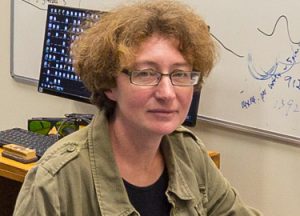
FLEET’s first three Women in FLEET Fellows: Dr Semonti Bhattacharyya (Monash),
Dr Peggy Qi Zhang (UNSW), Dr Iolanda Di Bernardo (Monash)
FLEET’s goal is to achieve 30% representation of women at all levels across FLEET.
To begin to move towards this goal, we needed innovative approaches that would allow us to begin ‘shifting the dial’.
One innovative initiative that has met with success was FLEET’s new women-only Fellowships, offered in multiple locations, and across all fields of study in the Centre.
This was the first such initiative for a Centre funded by the Australian Research Council, and the number of applications was extremely high, indicating that the Fellowship was successful at locating talent overlooked in previous, more tightly targeted searches.
The process was not without challenges, and the description below is aimed at helping other multi-institution research entities that might try similar approaches.
Background
Prior to establishing the new Fellowships, FLEET’s Equity & Diversity Policy included:
- Equity and Diversity Committee representation on all selection panels.
- Implicit bias awareness ensured for all members of selection panels.
- An aim to produce shortlists with equal representation of women and men. In cases where this is not possible, a justification must be provided to the FLEET Equity & Diversity Committee.
However, these measures alone were not sufficient…
After the Centre’s first year of operation, representation of women among FLEET postdoctoral fellows remained noticeably lower than the 30% goal. At the end of 2018, 14 fellows had been appointed after searches, of which three (21%) were women, and an additional 17 appointments were made directly, of which four (24%) were women.
FLEET’s Equity & Diversity Committee and Executive Committee identified three significant reasons for the failure to meet our goal:
- While there are a number of valid reasons for direct appointments instead of external searches, in some cases, these direct appointments can pass along the existing inequity in the system.
- Targeted searches for positions requiring highly defined skillsets result in small total numbers of applicants (and even smaller numbers of women applicants), and unconscious biases may be more difficult to avoid in these situations. For example, a shortlist containing four men and no women from a total pool of 12 men and three women may be viewed as a statistical fluctuation, while a similar shortlist from a pool of 120 men and 30 women is more likely to be a signal of bias.
- Targeted searches for positions requiring highly defined skillsets may result in negative self-selection by women applicants who feel they are less than a perfect fit to the selection criteria.
To directly address these challenges, the Equity & Diversity Committee and Executive Committee approved a plan to offer two Women in FLEET Fellowships.
The key features of the Women in FLEET Fellowships are:
- The Fellowships are funded 50% by FLEET strategic funds, and 50% from the research funds of the Centre node(s) hosting the Fellow, which incentivises the senior investigators who will work with the Fellow but also ensures they are invested in the research.
- Fellowships target early-career researchers (<5 years past PhD) who self-identify as female and have research interests aligning with any research areas within FLEET, giving applicants the choice to nominate which investigators they want to work with.
- The Women in Fellowship position was advertised as a 3-year fixed-term appointment at Level A or B depending on experience.
- The Fellowships therefore allowed for improved flexibility in the location and type of position on offer. This broader search has allowed FLEET to find excellent researchers who may have been missed in previous, narrowly-targeted searches.
Implementation, and negotiating red tape

A/Prof Elena Ostrovskaya is Chair of FLEET’s Equity and Diversity Committee and led the Women in FLEET program.
The recruitment process for the Women in FLEET Fellowships had to comply with equity and recruiting policies across all seven FLEET member universities, which posed significant challenges and required a flexible response.
- The application process consisted of a centralised expression of interest stage (via FLEET website) followed by (directed) applications to specific nodes that allow “women only” positions to be advertised. Expression of interest calls were placed in maximum-impact, international job-seeking platforms – Nature jobs, IOP Bright recruits, Physics Today jobs, UniJobs, Seek and LinkedIn.
- Calls for applications were synchronised at the two FLEET nodes that allowed women-only recruitment to go through the respective HR divisions
- At one university, significant discussion was required to gain agreement for FLEET to advertise the position independently
- At nodes whose internal guidelines did not allow them to advertise women-only positions, Fellows were directly appointed at FLEET’s administering node, and appointed to the hosting node through honorary appointment arrangements.
- To meet visa requirements for overseas applicants, the Centre’s administering node recognised the FLEET website as an internal job board.
Implementation of a coordinated search across several nodes was not trivial. Given the nature of the positions, a single search involving a single selection committee was ideal. However the search had to satisfy HR requirements at each node that might host a Fellow.
Additionally, some nodes were ineligible due to insufficient research funds to support a Fellow.
This innovative approach to recruitment is also legally challenging due to Australian anti-discrimination laws, although state laws allow the Universities to apply for exemptions (for example, the 1991 ACT Discrimination Act allows for ‘special measures’ including positive actions intended to achieve equality for specific disadvantaged groups).
Outcomes:
The response to our call for applicants exceeded expectations.
- 68 applications were received (15 previous, more-targeted searches received 28 women applicants in total, an average of less than two women per search)
- 11 applicants were shortlisted, and interviewed over several weeks
- Three Fellowship positions were offered at two nodes. Two were funded 50% by strategic funds, and a third position was offered 100% funded by researcher funds. A further two shorter appointments were also offered due to availability of short-term funding.
The response to the Women in FLEET Fellowship was significantly greater than the combined response of women to advertising for 15 previous, individual, targeted research fellow positions.
Thus, it is clear that the Women in FLEET Fellowship strategy reached applicants who were missed by our previous recruitment efforts.
Potential reasons for the increased response include:
- Increased visibility of a Centre-wide search
- Decrease in negative self-selection of applicants that result from stringent selection criteria for a particular skillset
- Increased positive self-selection of women to apply for a women-only position.
Conclusions
Prior to the Fellowship, FLEET’s recruitment efforts drew from the existing pool of researchers in physics, which (along with related fields such as engineering and material science) unfortunately features a relatively low percentage of women.
The response to the Women in FLEET fellowship was significantly greater than the combined response of women to advertising for 15 individual, targeted research fellow positions. The strategy successfully reached applicants who were missed by our previous advertising.
Women-only recruitment effort such as Women in FLEET Fellowship, as part of the recruitment strategy of a large Centre, appears to be a well-justified approach for increasing gender equity in searches at the postdoctoral level, particularly in fields that have low representation of women.
Given the increased response of women applicants to a broad-based search compared to narrowly targeted searches, it is possible that gender-blind, broad-based searches may also result in increased numbers of women applicants.
We hope that this case study is a useful guide to other research centres and organisations wishing to take a proactive approach to gender equity in STEM research. We hope that others will consider adopting this recruitment strategy, and communicate their findings as we have done.
We also hope that, collectively, such efforts will allow us to increase the percentage of women above the average in our respective research fields, moving towards a more equitable STEM environment in Australia.
Authors:
- A/Prof Elena Ostrovskaya is leader of FLEET’s research node at the Australian National University, and Chair of the Centre’s Equity and Diversity Committee
- Prof Michael Fuhrer is Director of FLEET
- Dr Tich-Lam Nguyen is Chief Operating Officer of FLEET
- Errol Hunt is Senior Communications Coordinator at FLEET
FLEET is the Australian Research Council Centre of Excellence in Future Low-Energy Electronics Technologies
@FLEETCentre

